Comprehensive Analysis of a Primary Healthcare Clinic's Operations
VerifiedAdded on 2022/05/13
|6
|1589
|28
Report
AI Summary
This report delves into the analysis of a primary healthcare clinic, exploring the social, economic, and political factors that influence its operations. It examines the clinic's mission statement, emphasizing the importance of patient opinions and effective leadership in providing quality services. The report further investigates potential growth strategies, such as organizing house-to-house health services and leveraging technological advancements. It outlines methods for determining if the clinic is meeting its goals, including the incorporation of technology for performance measurements. Finally, the report addresses opportunities for improvement, focusing on patient satisfaction and quality assurance policies. References are provided to support the analysis.
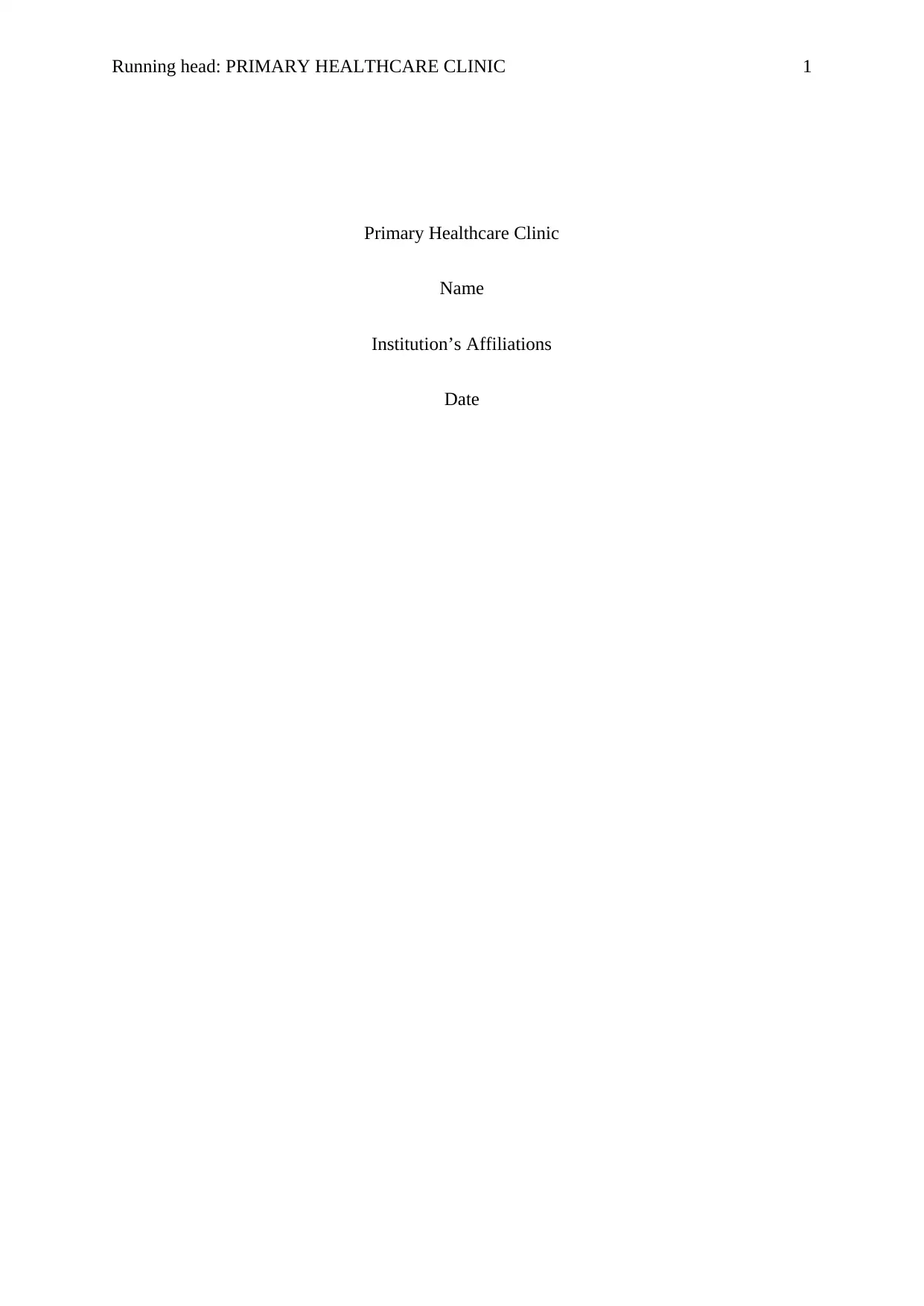
Running head: PRIMARY HEALTHCARE CLINIC 1
Primary Healthcare Clinic
Name
Institution’s Affiliations
Date
Primary Healthcare Clinic
Name
Institution’s Affiliations
Date
Paraphrase This Document
Need a fresh take? Get an instant paraphrase of this document with our AI Paraphraser
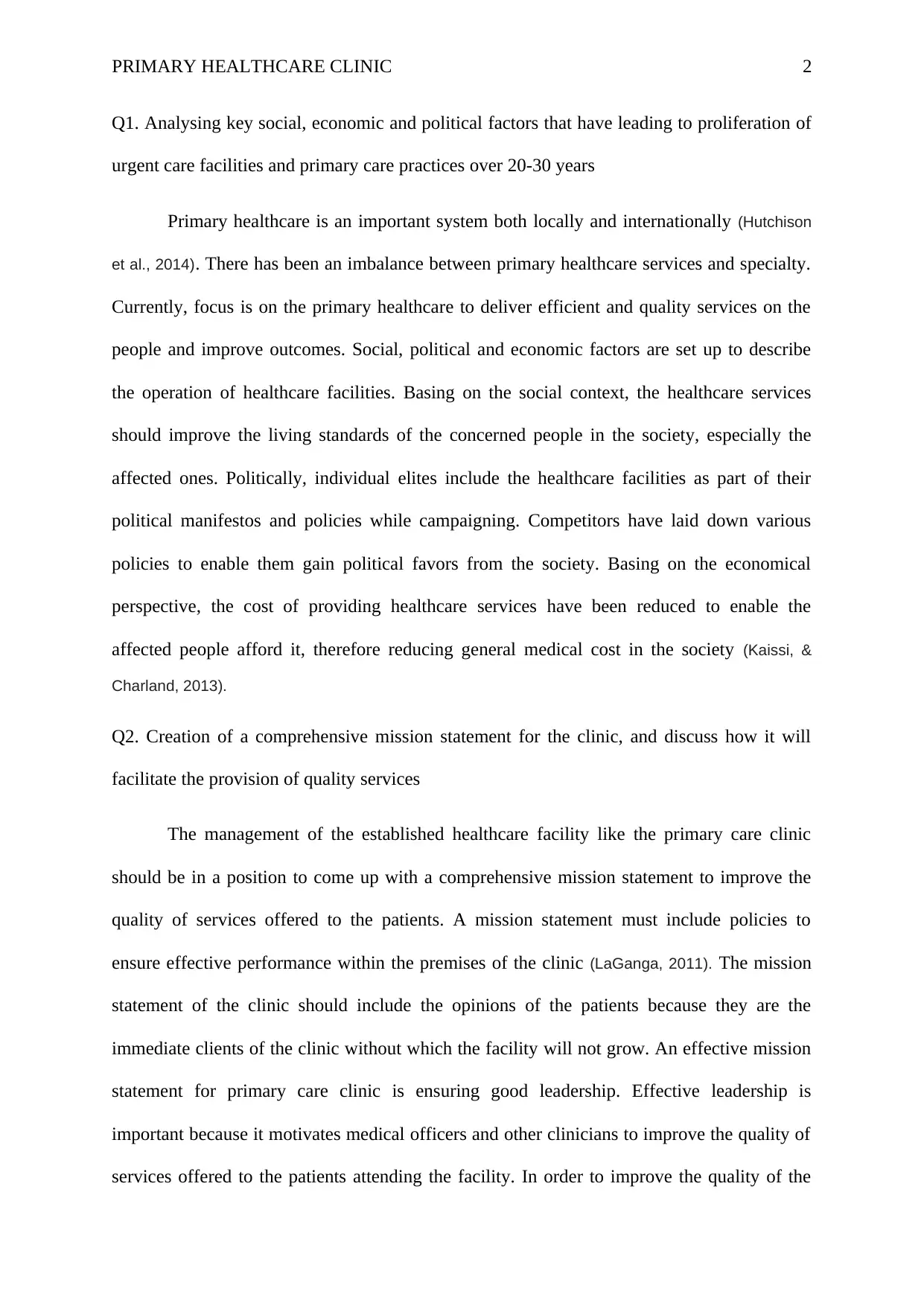
PRIMARY HEALTHCARE CLINIC 2
Q1. Analysing key social, economic and political factors that have leading to proliferation of
urgent care facilities and primary care practices over 20-30 years
Primary healthcare is an important system both locally and internationally (Hutchison
et al., 2014). There has been an imbalance between primary healthcare services and specialty.
Currently, focus is on the primary healthcare to deliver efficient and quality services on the
people and improve outcomes. Social, political and economic factors are set up to describe
the operation of healthcare facilities. Basing on the social context, the healthcare services
should improve the living standards of the concerned people in the society, especially the
affected ones. Politically, individual elites include the healthcare facilities as part of their
political manifestos and policies while campaigning. Competitors have laid down various
policies to enable them gain political favors from the society. Basing on the economical
perspective, the cost of providing healthcare services have been reduced to enable the
affected people afford it, therefore reducing general medical cost in the society (Kaissi, &
Charland, 2013).
Q2. Creation of a comprehensive mission statement for the clinic, and discuss how it will
facilitate the provision of quality services
The management of the established healthcare facility like the primary care clinic
should be in a position to come up with a comprehensive mission statement to improve the
quality of services offered to the patients. A mission statement must include policies to
ensure effective performance within the premises of the clinic (LaGanga, 2011). The mission
statement of the clinic should include the opinions of the patients because they are the
immediate clients of the clinic without which the facility will not grow. An effective mission
statement for primary care clinic is ensuring good leadership. Effective leadership is
important because it motivates medical officers and other clinicians to improve the quality of
services offered to the patients attending the facility. In order to improve the quality of the
Q1. Analysing key social, economic and political factors that have leading to proliferation of
urgent care facilities and primary care practices over 20-30 years
Primary healthcare is an important system both locally and internationally (Hutchison
et al., 2014). There has been an imbalance between primary healthcare services and specialty.
Currently, focus is on the primary healthcare to deliver efficient and quality services on the
people and improve outcomes. Social, political and economic factors are set up to describe
the operation of healthcare facilities. Basing on the social context, the healthcare services
should improve the living standards of the concerned people in the society, especially the
affected ones. Politically, individual elites include the healthcare facilities as part of their
political manifestos and policies while campaigning. Competitors have laid down various
policies to enable them gain political favors from the society. Basing on the economical
perspective, the cost of providing healthcare services have been reduced to enable the
affected people afford it, therefore reducing general medical cost in the society (Kaissi, &
Charland, 2013).
Q2. Creation of a comprehensive mission statement for the clinic, and discuss how it will
facilitate the provision of quality services
The management of the established healthcare facility like the primary care clinic
should be in a position to come up with a comprehensive mission statement to improve the
quality of services offered to the patients. A mission statement must include policies to
ensure effective performance within the premises of the clinic (LaGanga, 2011). The mission
statement of the clinic should include the opinions of the patients because they are the
immediate clients of the clinic without which the facility will not grow. An effective mission
statement for primary care clinic is ensuring good leadership. Effective leadership is
important because it motivates medical officers and other clinicians to improve the quality of
services offered to the patients attending the facility. In order to improve the quality of the
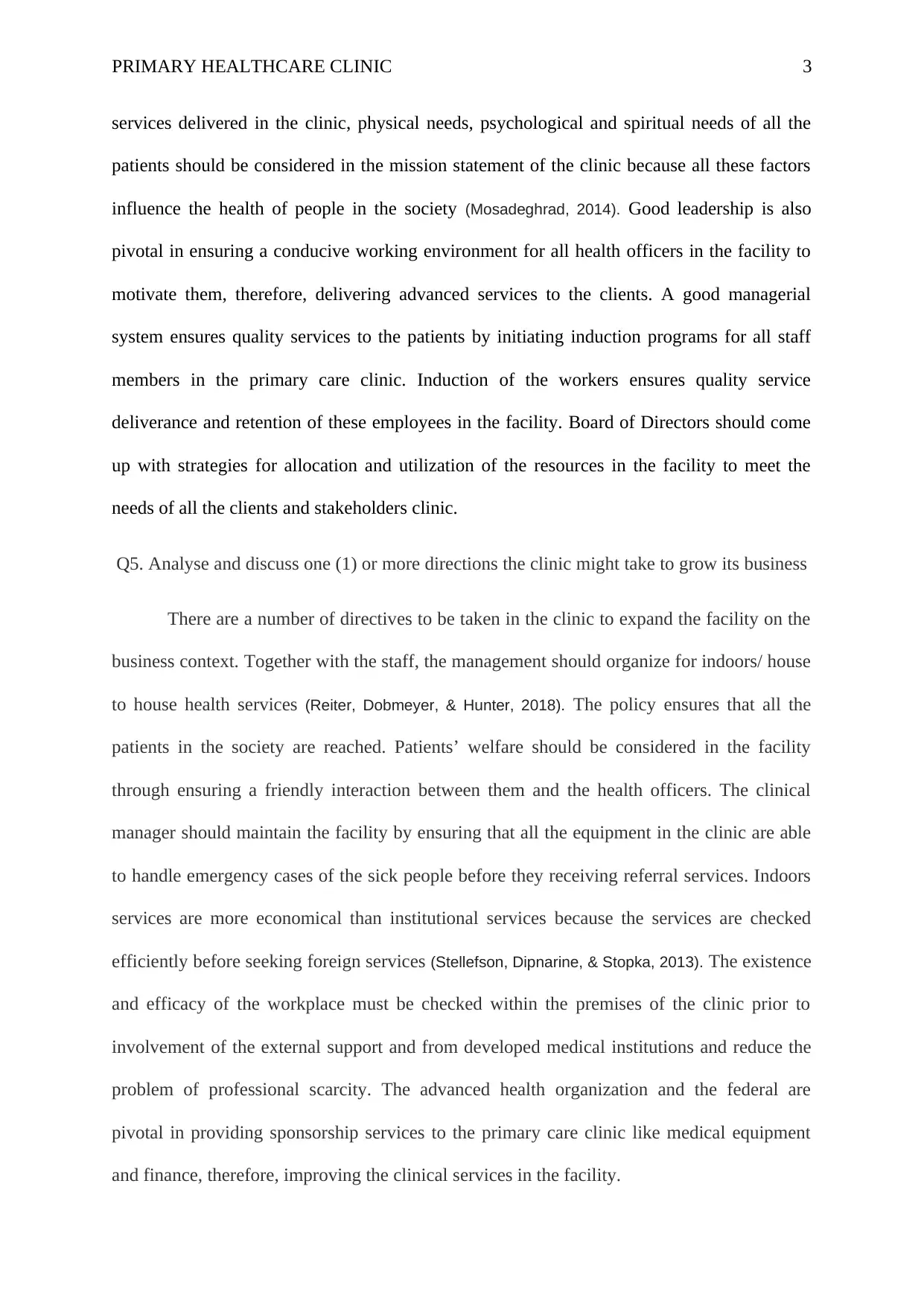
PRIMARY HEALTHCARE CLINIC 3
services delivered in the clinic, physical needs, psychological and spiritual needs of all the
patients should be considered in the mission statement of the clinic because all these factors
influence the health of people in the society (Mosadeghrad, 2014). Good leadership is also
pivotal in ensuring a conducive working environment for all health officers in the facility to
motivate them, therefore, delivering advanced services to the clients. A good managerial
system ensures quality services to the patients by initiating induction programs for all staff
members in the primary care clinic. Induction of the workers ensures quality service
deliverance and retention of these employees in the facility. Board of Directors should come
up with strategies for allocation and utilization of the resources in the facility to meet the
needs of all the clients and stakeholders clinic.
Q5. Analyse and discuss one (1) or more directions the clinic might take to grow its business
There are a number of directives to be taken in the clinic to expand the facility on the
business context. Together with the staff, the management should organize for indoors/ house
to house health services (Reiter, Dobmeyer, & Hunter, 2018). The policy ensures that all the
patients in the society are reached. Patients’ welfare should be considered in the facility
through ensuring a friendly interaction between them and the health officers. The clinical
manager should maintain the facility by ensuring that all the equipment in the clinic are able
to handle emergency cases of the sick people before they receiving referral services. Indoors
services are more economical than institutional services because the services are checked
efficiently before seeking foreign services (Stellefson, Dipnarine, & Stopka, 2013). The existence
and efficacy of the workplace must be checked within the premises of the clinic prior to
involvement of the external support and from developed medical institutions and reduce the
problem of professional scarcity. The advanced health organization and the federal are
pivotal in providing sponsorship services to the primary care clinic like medical equipment
and finance, therefore, improving the clinical services in the facility.
services delivered in the clinic, physical needs, psychological and spiritual needs of all the
patients should be considered in the mission statement of the clinic because all these factors
influence the health of people in the society (Mosadeghrad, 2014). Good leadership is also
pivotal in ensuring a conducive working environment for all health officers in the facility to
motivate them, therefore, delivering advanced services to the clients. A good managerial
system ensures quality services to the patients by initiating induction programs for all staff
members in the primary care clinic. Induction of the workers ensures quality service
deliverance and retention of these employees in the facility. Board of Directors should come
up with strategies for allocation and utilization of the resources in the facility to meet the
needs of all the clients and stakeholders clinic.
Q5. Analyse and discuss one (1) or more directions the clinic might take to grow its business
There are a number of directives to be taken in the clinic to expand the facility on the
business context. Together with the staff, the management should organize for indoors/ house
to house health services (Reiter, Dobmeyer, & Hunter, 2018). The policy ensures that all the
patients in the society are reached. Patients’ welfare should be considered in the facility
through ensuring a friendly interaction between them and the health officers. The clinical
manager should maintain the facility by ensuring that all the equipment in the clinic are able
to handle emergency cases of the sick people before they receiving referral services. Indoors
services are more economical than institutional services because the services are checked
efficiently before seeking foreign services (Stellefson, Dipnarine, & Stopka, 2013). The existence
and efficacy of the workplace must be checked within the premises of the clinic prior to
involvement of the external support and from developed medical institutions and reduce the
problem of professional scarcity. The advanced health organization and the federal are
pivotal in providing sponsorship services to the primary care clinic like medical equipment
and finance, therefore, improving the clinical services in the facility.
⊘ This is a preview!⊘
Do you want full access?
Subscribe today to unlock all pages.

Trusted by 1+ million students worldwide
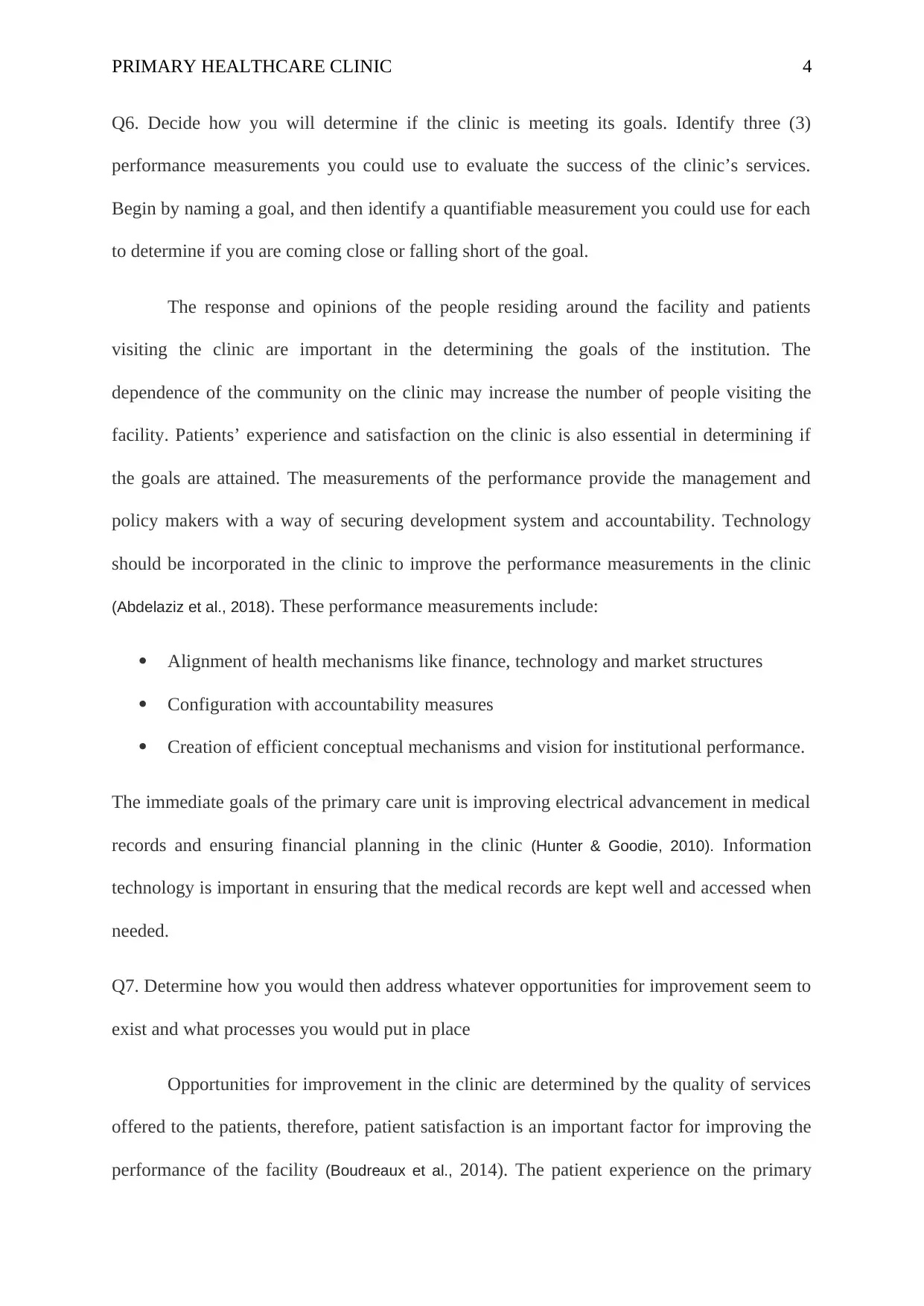
PRIMARY HEALTHCARE CLINIC 4
Q6. Decide how you will determine if the clinic is meeting its goals. Identify three (3)
performance measurements you could use to evaluate the success of the clinic’s services.
Begin by naming a goal, and then identify a quantifiable measurement you could use for each
to determine if you are coming close or falling short of the goal.
The response and opinions of the people residing around the facility and patients
visiting the clinic are important in the determining the goals of the institution. The
dependence of the community on the clinic may increase the number of people visiting the
facility. Patients’ experience and satisfaction on the clinic is also essential in determining if
the goals are attained. The measurements of the performance provide the management and
policy makers with a way of securing development system and accountability. Technology
should be incorporated in the clinic to improve the performance measurements in the clinic
(Abdelaziz et al., 2018). These performance measurements include:
Alignment of health mechanisms like finance, technology and market structures
Configuration with accountability measures
Creation of efficient conceptual mechanisms and vision for institutional performance.
The immediate goals of the primary care unit is improving electrical advancement in medical
records and ensuring financial planning in the clinic (Hunter & Goodie, 2010). Information
technology is important in ensuring that the medical records are kept well and accessed when
needed.
Q7. Determine how you would then address whatever opportunities for improvement seem to
exist and what processes you would put in place
Opportunities for improvement in the clinic are determined by the quality of services
offered to the patients, therefore, patient satisfaction is an important factor for improving the
performance of the facility (Boudreaux et al., 2014). The patient experience on the primary
Q6. Decide how you will determine if the clinic is meeting its goals. Identify three (3)
performance measurements you could use to evaluate the success of the clinic’s services.
Begin by naming a goal, and then identify a quantifiable measurement you could use for each
to determine if you are coming close or falling short of the goal.
The response and opinions of the people residing around the facility and patients
visiting the clinic are important in the determining the goals of the institution. The
dependence of the community on the clinic may increase the number of people visiting the
facility. Patients’ experience and satisfaction on the clinic is also essential in determining if
the goals are attained. The measurements of the performance provide the management and
policy makers with a way of securing development system and accountability. Technology
should be incorporated in the clinic to improve the performance measurements in the clinic
(Abdelaziz et al., 2018). These performance measurements include:
Alignment of health mechanisms like finance, technology and market structures
Configuration with accountability measures
Creation of efficient conceptual mechanisms and vision for institutional performance.
The immediate goals of the primary care unit is improving electrical advancement in medical
records and ensuring financial planning in the clinic (Hunter & Goodie, 2010). Information
technology is important in ensuring that the medical records are kept well and accessed when
needed.
Q7. Determine how you would then address whatever opportunities for improvement seem to
exist and what processes you would put in place
Opportunities for improvement in the clinic are determined by the quality of services
offered to the patients, therefore, patient satisfaction is an important factor for improving the
performance of the facility (Boudreaux et al., 2014). The patient experience on the primary
Paraphrase This Document
Need a fresh take? Get an instant paraphrase of this document with our AI Paraphraser
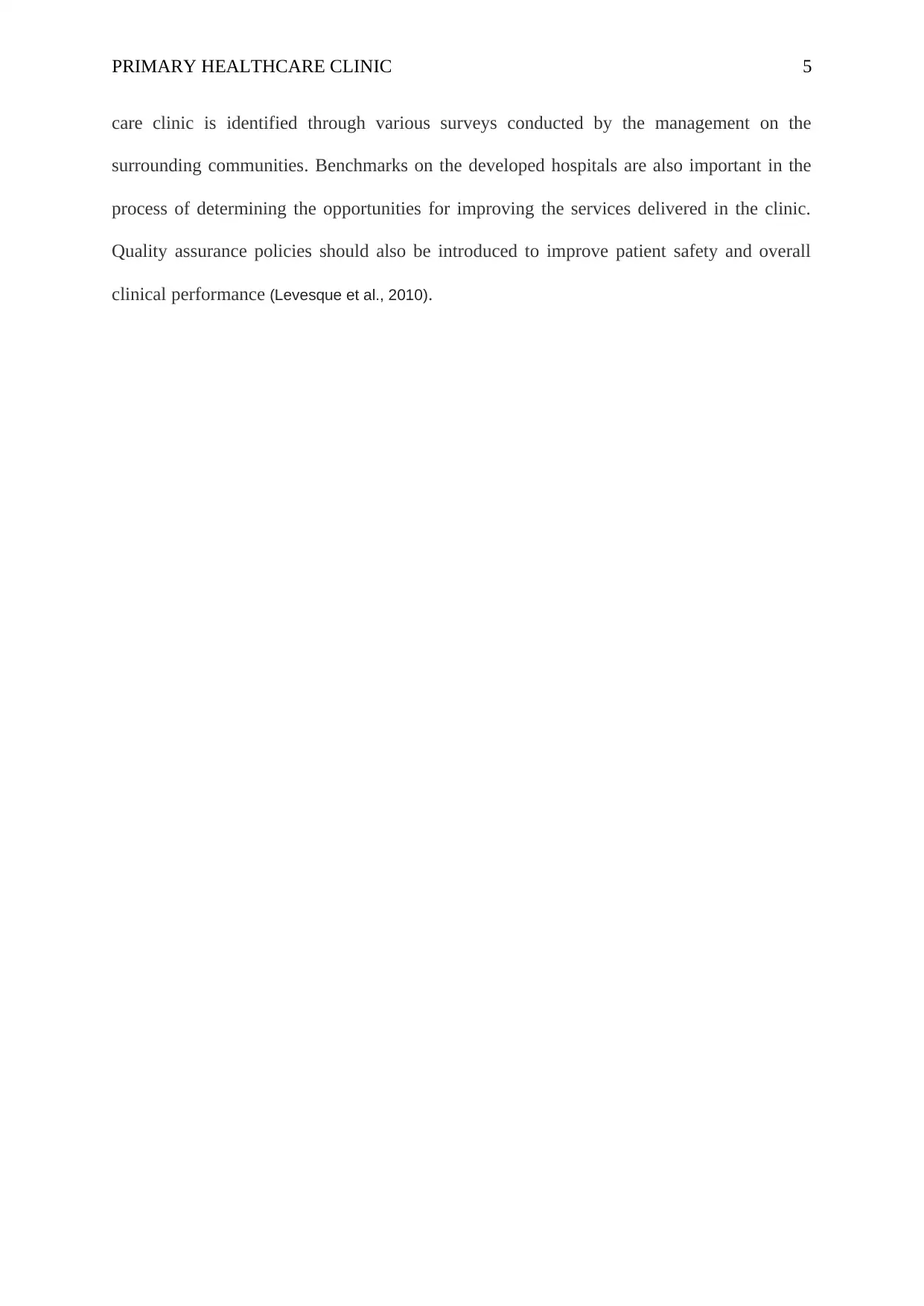
PRIMARY HEALTHCARE CLINIC 5
care clinic is identified through various surveys conducted by the management on the
surrounding communities. Benchmarks on the developed hospitals are also important in the
process of determining the opportunities for improving the services delivered in the clinic.
Quality assurance policies should also be introduced to improve patient safety and overall
clinical performance (Levesque et al., 2010).
care clinic is identified through various surveys conducted by the management on the
surrounding communities. Benchmarks on the developed hospitals are also important in the
process of determining the opportunities for improving the services delivered in the clinic.
Quality assurance policies should also be introduced to improve patient safety and overall
clinical performance (Levesque et al., 2010).
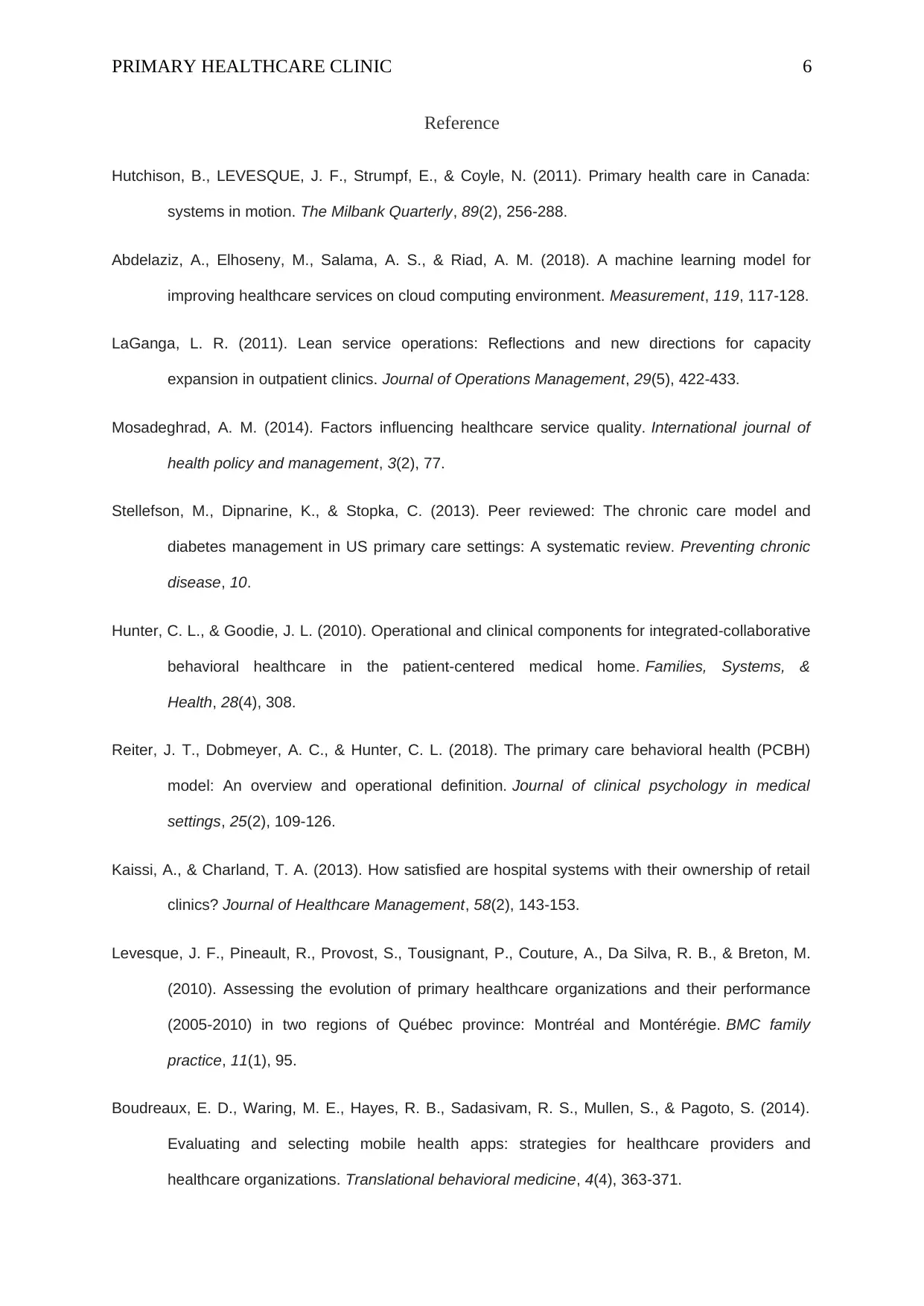
PRIMARY HEALTHCARE CLINIC 6
Reference
Hutchison, B., LEVESQUE, J. F., Strumpf, E., & Coyle, N. (2011). Primary health care in Canada:
systems in motion. The Milbank Quarterly, 89(2), 256-288.
Abdelaziz, A., Elhoseny, M., Salama, A. S., & Riad, A. M. (2018). A machine learning model for
improving healthcare services on cloud computing environment. Measurement, 119, 117-128.
LaGanga, L. R. (2011). Lean service operations: Reflections and new directions for capacity
expansion in outpatient clinics. Journal of Operations Management, 29(5), 422-433.
Mosadeghrad, A. M. (2014). Factors influencing healthcare service quality. International journal of
health policy and management, 3(2), 77.
Stellefson, M., Dipnarine, K., & Stopka, C. (2013). Peer reviewed: The chronic care model and
diabetes management in US primary care settings: A systematic review. Preventing chronic
disease, 10.
Hunter, C. L., & Goodie, J. L. (2010). Operational and clinical components for integrated-collaborative
behavioral healthcare in the patient-centered medical home. Families, Systems, &
Health, 28(4), 308.
Reiter, J. T., Dobmeyer, A. C., & Hunter, C. L. (2018). The primary care behavioral health (PCBH)
model: An overview and operational definition. Journal of clinical psychology in medical
settings, 25(2), 109-126.
Kaissi, A., & Charland, T. A. (2013). How satisfied are hospital systems with their ownership of retail
clinics? Journal of Healthcare Management, 58(2), 143-153.
Levesque, J. F., Pineault, R., Provost, S., Tousignant, P., Couture, A., Da Silva, R. B., & Breton, M.
(2010). Assessing the evolution of primary healthcare organizations and their performance
(2005-2010) in two regions of Québec province: Montréal and Montérégie. BMC family
practice, 11(1), 95.
Boudreaux, E. D., Waring, M. E., Hayes, R. B., Sadasivam, R. S., Mullen, S., & Pagoto, S. (2014).
Evaluating and selecting mobile health apps: strategies for healthcare providers and
healthcare organizations. Translational behavioral medicine, 4(4), 363-371.
Reference
Hutchison, B., LEVESQUE, J. F., Strumpf, E., & Coyle, N. (2011). Primary health care in Canada:
systems in motion. The Milbank Quarterly, 89(2), 256-288.
Abdelaziz, A., Elhoseny, M., Salama, A. S., & Riad, A. M. (2018). A machine learning model for
improving healthcare services on cloud computing environment. Measurement, 119, 117-128.
LaGanga, L. R. (2011). Lean service operations: Reflections and new directions for capacity
expansion in outpatient clinics. Journal of Operations Management, 29(5), 422-433.
Mosadeghrad, A. M. (2014). Factors influencing healthcare service quality. International journal of
health policy and management, 3(2), 77.
Stellefson, M., Dipnarine, K., & Stopka, C. (2013). Peer reviewed: The chronic care model and
diabetes management in US primary care settings: A systematic review. Preventing chronic
disease, 10.
Hunter, C. L., & Goodie, J. L. (2010). Operational and clinical components for integrated-collaborative
behavioral healthcare in the patient-centered medical home. Families, Systems, &
Health, 28(4), 308.
Reiter, J. T., Dobmeyer, A. C., & Hunter, C. L. (2018). The primary care behavioral health (PCBH)
model: An overview and operational definition. Journal of clinical psychology in medical
settings, 25(2), 109-126.
Kaissi, A., & Charland, T. A. (2013). How satisfied are hospital systems with their ownership of retail
clinics? Journal of Healthcare Management, 58(2), 143-153.
Levesque, J. F., Pineault, R., Provost, S., Tousignant, P., Couture, A., Da Silva, R. B., & Breton, M.
(2010). Assessing the evolution of primary healthcare organizations and their performance
(2005-2010) in two regions of Québec province: Montréal and Montérégie. BMC family
practice, 11(1), 95.
Boudreaux, E. D., Waring, M. E., Hayes, R. B., Sadasivam, R. S., Mullen, S., & Pagoto, S. (2014).
Evaluating and selecting mobile health apps: strategies for healthcare providers and
healthcare organizations. Translational behavioral medicine, 4(4), 363-371.
⊘ This is a preview!⊘
Do you want full access?
Subscribe today to unlock all pages.

Trusted by 1+ million students worldwide
1 out of 6
Related Documents
Your All-in-One AI-Powered Toolkit for Academic Success.
+13062052269
info@desklib.com
Available 24*7 on WhatsApp / Email
![[object Object]](/_next/static/media/star-bottom.7253800d.svg)
Unlock your academic potential
Copyright © 2020–2025 A2Z Services. All Rights Reserved. Developed and managed by ZUCOL.




